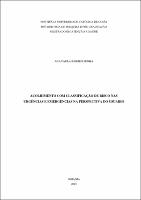| Compartilhamento |


|
Use este identificador para citar ou linkar para este item:
http://tede2.pucgoias.edu.br:8080/handle/tede/3148| Tipo do documento: | Dissertação |
| Título: | ACOLHIMENTO COM CLASSIFICAÇÃO DE RISCO NAS URGÊNCIAS E EMERGÊNCIAS NA PERSPECTIVA DO USUÁRIO. |
| Título(s) alternativo(s): | Reception with risk classification within urgency and emergency units through a patient s perspective. |
| Autor: | Zenha, Ana Paula Ribeiro  |
| Primeiro orientador: | Pereira, Milca Severino |
| Primeiro membro da banca: | Lima, Jacqueline Rodrigues de |
| Segundo membro da banca: | Vila, Vanessa da Silva Carvalho |
| Resumo: | Trata-se de um estudo descritivo exploratório com abordagem qualitativa, realizado nos meses de novembro de 2014 a fevereiro do ano de 2015, nas unidades de urgência e emergência de Goiânia, com o objetivo de analisar o processo de acolhimento com classificação de risco nessas unidades públicas, na visão do usuário. Participaram do estudo 68 usuários que estavam nas unidades de urgência e emergências selecionadas e que já haviam sido atendidos pela classificação de risco e receberam as especificações: amarela, verde e azul. Os dados foram coletados por meio de entrevista e observações diretas, registradas em diário de campo. Para a coleta de dados, foi utilizada a técnica de entrevista individual semiestruturada, gravada em áudio. Observamos que os usuários não foram devidamente orientados acerca do conceito e da aplicabilidade do acolhimento com classificação de risco nessas unidades e nem sobre os benefícios que esse método proporciona ao sistema público de saúde. Encontramos usuários insatisfeitos, porém a maioria se declarou bem atendida pela classificação de risco. Notamos que alguns, pela recorrência nessas unidades, haviam conseguido decifrar o funcionamento do dispositivo e encontrar formas para antecipação de seu atendimento médico, porém alegam que nunca houve esclarecimento por parte das instituições. Há certa aprovação do acolhimento com classificação de risco por parte dos usuários, pois muitos demonstraram compreender a diferença de gravidade dos que buscam atendimento nessas unidades e alegaram ficar mais seguros na espera pelo atendimento médico após serem consultados no setor de acolhimento. Concluímos que a conscientização dos usuários quanto ao funcionamento e objetivos do acolhimento com classificação de risco proporcionou maior compreensão do fluxo das unidades, ao identificar quais atendimentos são de urgência, favorecendo a reorganização do fluxo interno da unidade, apontando uma sutil conscientização acerca da unidade que o usuário deve recorrer em suas necessidades de saúde, além de proporcionar segurança aos usuários e profissionais envolvidos no processo de classificação de risco, assim que esses usuários chegam às unidades de urgência e emergência. |
| Abstract: | It is a descriptive and exploratory study with a qualitative approach, conducted from November of 2014 to February of 2015 in urgency and emergency units in the city of Goiania, aiming to analyze the reception process with risk classification within these public units through a client s perspective. 68 clients took part of this study. They were in the urgency and emergency units selected and they had been taken care of through the risk classification and had received the specifications: yellow, green and blue. The data was collected through interviews and direct observation and registered in a field diary. In order to collect the data, it was used the technique of semi structured individual interview taped in audio. It was observed that clients were not well guided on the concept and applicability of the reception with risk classification within these units nor on the benefits this method allows to the public health system. There were unhappy clients, but the majority found itself happy with the risk classification. It was observed that some of them, due to the recurrence to these units, have discovered how the system worked and found ways to anticipate their medical care. However, they declared that there was never a clarification from the institutions. There is a certain degree of approval of the reception with risk classification from part of the clients, for many of them demonstrated to understand the difference in the seriousness of those who seek care in these units saying that they felt safer waiting for the care after being trialed in the reception unit. The study has concluded that the client awareness of how the system works and the goals of the risk classification have provided them with a better understanding of the units flow in identifying which cases are urgent, allowing the reorganization of the internal unit flow and indicating a subtle level of awareness of which unit the client should go to in order to have his or her needs attended and also offering safety to clients and professionals involved in the risk classification process as soon as the patients arrive in urgency and emergency units. |
| Palavras-chave: | Acolhimento Classificação de Risco Programa Nacional de Humanização SUS reception, risk classification Humanization National Program SUS |
| Área(s) do CNPq: | CNPQ::CIENCIAS DA SAUDE::ENFERMAGEM |
| Idioma: | por |
| País: | BR |
| Instituição: | Pontifícia Universidade Católica de Goiás |
| Sigla da instituição: | PUC Goiás |
| Departamento: | Ciências da Saúde |
| Programa: | Programa de Pós-Graduação STRICTO SENSU em Atenção à Saúde |
| Citação: | ZENHA, Ana Paula Ribeiro. Reception with risk classification within urgency and emergency units through a patient s perspective.. 2015. 44 f. Dissertação (Mestrado em Ciências da Saúde) - Pontifícia Universidade Católica de Goiás, GOIÂNIA, 2015. |
| Tipo de acesso: | Acesso Aberto |
| URI: | http://localhost:8080/tede/handle/tede/3148 |
| Data de defesa: | 29-Jun-2015 |
| Aparece nas coleções: | Mestrado em Atenção à Saúde |
Arquivos associados a este item:
| Arquivo | Descrição | Tamanho | Formato | |
|---|---|---|---|---|
| ANA PAULA RIBEIRO ZENHA.pdf | 437,96 kB | Adobe PDF |  Baixar/Abrir Pré-Visualizar |
Os itens no repositório estão protegidos por copyright, com todos os direitos reservados, salvo quando é indicado o contrário.




